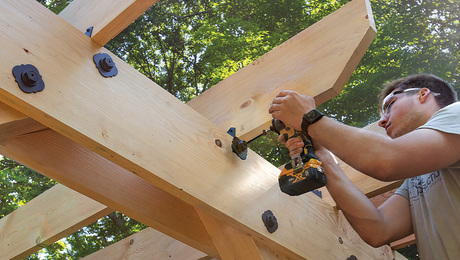I expect to get a lot of laughs on this one, but hear me out, then tear this down…
I’m re-doing a tile job in the bathroom of the apartment side of the duplex I live in. The previous owners did a terrible tile job about 6 years ago; the subflooring was insufficient(Two layers of 1 X 6) and the tiles around the toiletstarted prying up when the toilet sunk(Due to rot of the original subfloor, a prior condition).
I’ve beefed up the floor, removed the rot, and now have 2 layers of 3/4 plywood, plus a layer of cement board.
So, here’s the dilemma- A carpenter friend(Admittedly not a tile installer) suggested that I do a dry run layout of the tiles and spacers, and rather than bring up all the tiles and run a layer of thinset, and lay the tiles back in, he suggested I pull up each tile individually, lay a sprial pattern of heavy duty liquid nails on each tile, and press the tile back into place against the cement board until I feel contact with the cement board uniformly under the tile.
He has done this type on installation in his own house, both in small flooring applications like mine, and in tile countertop applications. He claims that the longest such installation is five years old, with no cracked grout or other damage, and that the liquid nail if applied in the right pattern does not leave any tiles with a “hollow” sound or feel. The real advantage of this method is that I won’t have to take up all the tiles after I do my dry layout. I can pick them up and adhere them one at a time.
Is this crazy? I’m using 12 X 12 tiles, and while I want to do the best job possible, my curiousity is really peaked by this method. I’ve never layed tile, used thinset, etc, so that method is slightly daunting to me. Plus I need to have this floor tiled by friday…
Also should I be taping the seams of the cement board with durock, regardless of the method used?
Please tell me the pros and cons you might think up.
Thanks much,
Joel



















Replies
I'm not a tile guy, but why do you have to take all the tiles out and thinset the whole floor? Would it be possible to just "butter" the underside of the tile and set it back down with morter. I guessing as long as you have morter consistantly across full tile it is the same thing as putting morter on floor. Thereby acomplishing the same thing that the glue was doing, only this time with tried and true morter. Just an idea, and i wish i knew if it was a good one.
Sconnyite,
More experienced advice will probably be around shortly but my concern centers on how the LNs will react to the higher levels of moisture in a bathroom. Also, does LNs provide the bonding strength needed between tiles and the backer board? Thinset gets 100% proof positive coverage, making a solid bond between the tile and backer. I have pulled up many loose tile due to poor thinset application, a dab here or there was thought to do the job. It seems the coverage of LNs wouldn’t be close to what you could get with thinset.
It has been my experience that the longest, most labor intensive part of tiling is the dry fit. It is here that you spend 75% of your time. I think it would be more work to remove each tile one by one, carefully LN each tile and replace. I don’t think you are saving any time at all, if anything the job will take you longer. Combined with the unclear long term results I would stick with proven techniques.
the rot removal and replcement sound good for a solid floor
are your two layers of ply glued and screwed together and each layer perpendicular?
two sheets 3/4 glued/screwed together are super rigid, so spongy floor should not be a problem
Use a joint/crack isolation membrane i cant spell it but "schlueder"? makes a good one (ask tile house), ultra set or superflex thinset the membrane down (soupy mud helps), Tile as normal...
ultra and super flex plus the membrane have enough elasticity for your appl..
two ply glued screwed plus cement board , dude ,youre there!
Liguid nails...great for one or two tiles on a wall. Sucks on the floor, poor adhesion to cement board unless super clean and dry
Tape seems and spots bith chunks missing with fiberglass mesh tape and thinset, smooth trowel seams flat
Use white thinset it cleans up easier
have fun
Okay, so I'm definately leaning away from the liquid nails, but now I have thinset questions... What kind of referencing system do you use to make sure you are setting the tiles back in exactly the same place and orientation on the floor that you had in the dry layout after you've started putting down thinset? The thinset would cover and marks you've made. Also, how thick a layer of thinset should you use on a 12 X 12 install?
I suggest you pick up a book on tile layout. Michael Byrne or John Bridge have excellent books.The concept is that you need two reference lines exactly 90 degrees to eachother near the center of the room. Because rooms are often not square you need to pick the most visible wall to reference the square reference lines from, usually the one accross from the entrance.There is rarely a need to dry fit all the tiles. I simply measure the tile and add a single grout line width. You may want to dry fit one row of tile along the reference axis and make sure that the cuts at the edges are both equal and not skinny. The equal part is easy, just adjust the reference line in or out. The not skinny part will involve perhaps taking cuts off the last 2-3 tiles, rather than having a skinny tile at the end, which looks terrible. Once you have that axis set, snap another reference line for the new center of the room which will be centered on the center of the grout line for the center most tile. I usually snap that line with a different color chaulk box or use a shapie and some straight edges. Now do the same on the verticle axis.If your area is very large or you are unsure of your skills, then snap some more reference lines along the center of grout lines say every 5-10 tiles, in both axis. Don't use liquid nails. Period.
For an entire bathroom floor forget the LiquidNails route. The experience I have is where the product label recommends that after gunning the mastic, you are to pull the material away and let it off-gas and tack-up for anywhere from 3 to 8 minutes. How many tiles?To keep your "layout", snap chalk lines perpendicular to the wall and 90° off these, and work within one of the smaller sections at a time. Typically, floor tiles are laid with a rather wide spacing, compared to wall tile which are butted lug-to-lug. All home centers carry the supplies you will need. Chalkbox, tile spacers, notched trowel, thinset, sponges (2 min. 3 better), tile grout, rubber float and kneepads. For 12" tiles purchase a trowel with 1/4" notches. When you are troweling-out the proper thin set, it is first spread using the non-notched trowel edge, once a good bond is made to the substrate, then go over it with the notched edge, holding the tool at an approximate 50° angle. While some DIYers mistakenly bed the spacers in the thinset, the recommended method is to insert only one leg of the "T" shape between tiles. These can be removed later, but some time before the thinset hardens.After the tiles are set, then it's time for the grouting process. If your layout has tile/tile spacing more than 1/8" then I'd recommended the "sanded grout.
Check with your local home center, some offer mini-classes on various home projects. Laying tile is almost always on the curriculoum.
A lot of good ideas/suggestions here, a couple of things I forgot though..
Dry set single row about 5+ ft on the floor with spacers in but not squished together
and mark edges of tile on a "storypole stick" use it to lay out room centered on door, tub wall, to get the most full tile i.e...full tile from one wall with a large cut on the oposite wall looks a lot better and quicker than cuts on both sides.Snap a line about three tiles away from the wall, spread thinset and set tiles( 1/4 notch trowell or a 3/8 if your floor is lumpy)
latex modified are the heat for thinset, or add an acrylic modifier follow directions
White thinset is easier to clean, cold clean water and a good grout sponge gets it off of most surfaces. Wet, rub with sponge or finger for walls works, use a piece of a stick or margin trowel to touch up joints.set as many full tiles as possible one day, next day you can gently walk on floor to mark, cut and set all the pieces and if you are carefull you can grout it in the afternoon (pull spacers first!)
Good Luck!
I cut the board twice and its still too short ! ! !
Man, I just typed you a step by step method using thinset over your taped concrete board, then CPE, then thinset again to set the ceramic tile but my ISP cut me off. If you really want to protect that floor from renters you will need more than grout sealer once a year. If want the answer (Chlorinated Polyethylene Membrane) let me know--be there and done that. Tyr
The bathroom can't be very large ... 60 sf at most? And using 12" tiles means there's not many to handle. Skip the liquid nails idea ... like someone said, it can work for a small repair job, but for an entire floor you need to do it right.
Figue out your layout, mark some lines on the floor, and butter the backs of the first few tiles so you don't cover the lines. Back buttering can be a bit messy cuz you have to cover the tile from edge to edge ... evenly ... then find a way to flip it over without getting too much on your hands. A 1/4" x 3/8" square notch trowel would work for you.
Don't fill the cement board seams with durock ... that's a sheetrock product. Use thinset.
Today is Tuesday. Lay the tile today & Wednesday, cleanup and grout Thursday, final clean for an hour (at most) on Friday, and you're done. You don't save anything with liquid nails ... it takes the same time to do the layout, and the grout , and cutting the tiles.
You shopuldn't be getting many laughs about your question, cuz you had sense enough to ask first. Now if you had come here and bragged about how you did the job with LN and how well it turned out , that's a different story. We're all laughing about your buddy who claims it's a proven method.
"When asked if you can do something, tell'em "Why certainly I can", then get busy and find a way to do it." T. Roosevelt
Edited 8/16/2005 3:07 pm ET by FastEddie
FastEddie,You said, "Don't fill the cement board seams with durock ... that's a sheetrock product."Durock is USG's brand of cement backer board, not some kind of mud. Just keeping the confusion at arm's length.Bill
Dunwright, Fast Eddie, Scooter and all others who responded,Thanks to all of you for your excellent advice. I will follow it. I'll look for the books you mentioned at my library, they have a well stocked Home Imp. section. I miswrote when I mentioned taping the seams with Durock. The durrock instructions say to tape it either with DuraBOND, or with thinset. On this forum's advise, I'll go for the thin set.Also, this bathroom floor is only 65" X 67", which will mean I'm laying less than 36 tiles after grout spacing. It's probably a good job to learn on, given that I won't personally have to live with the results....I'm hoping the tub(On the wall opposite the doorway) will provide a good reference point for starting the tiles, and I'll know when I do the dry layout. If not, I'll work with the line methods, which might be more impotant on a larger area.Thanks for the time frame, that was helpful. I also need to seal the grout, and I'm hoping there's not too much thought that needs to go into selecting a sealer.One last thing- Of what importance to me is the difference between thinset types(Latex modified, non latex modified).You guys have been a great help. Thanks again.Joel
Ok I cleaned my glasses and see that durock is not durabond. I interpreted that you would be filling the joints with the fast-setting sheetrock joint compound ... whatever it's called. You don't want to do that. Use the thinset, it's already mixed up and ready to go.
Do not use the edge of the bathtub as a reference line. Chances are it has a little curve.
Latex modifird thinset has a little flex to it. There are times when unmodified thinset is appropriate, and some people buy unmodified and then add a latex modifier.
"When asked if you can do something, tell'em "Why certainly I can", then get busy and find a way to do it." T. Roosevelt
Sconnyite
I purchased an inexpensive laser from Lowe's ($19.00). I do not remember the brand but it looks similar to a measuring tape housing. It is adjustable up and down as well as side by side.
I lay out my center line on the floor and make a mark on the far wall. I then tape the laser to the floor outside the room you will be working in. Adjust the laser so that you are lined up on both reference marks. Spread your thinset and lay your tile along this line. The laser line won't get buried under your thinset.
After you have established this row of tile you can move the laser to shoot 90* off of this row or just stack the tile using spacers. With 12 x 12 tiles you probable will not need to do this last step. Hope this helps
LF
No way on the liquid Nails---Your buddy said it lasted 5 years? If you wanted a floor that lasted 5 years, then you'de be putting in Vinyl roll flooring, but ceramic done right can last a lifetime.
Don't dry fit, have a little confidence in your self----measure and work it out of paper. I always snap a line in the center of the room......1/4'' to one side for the grout line, then i snap another, splitting the room into 4 sections. The thinset bag tells how to mix it. Don't mix a ton, you can always make more. Make it the consistency of a Frosty from wendy's and you're ready. Use a 1/4 inch notched trowel and spread enough thin set down to set a couple tiles. Don't get a head of your self, do a few at a time and use the spacers---sticking one end in--thats two spacers on each side of the tile.
Make sure you let the thinset dry 24 hours before grouting. On your durarock seams...on but joints use mesh tape and butter in with thinset and a 6 inch drywall knife...on the sides of the boards, just butter in. Let this dry before tiling.
I know that everybody is giving you instructions, and it is kinda confusing, but ceramic tile is really easy--if you have any carpentry skill and commen sense!
Get a library book with pictures.....!!!
This might seem kinda dumb, but ... even though you mark the center of the room, be careful starting there. You need to be able to reach all the tiles without leaning on any freshly set ones. If you start in the middle of the room, you might not be able to reach the ones along the back wall. Work towards the door.
"When asked if you can do something, tell'em "Why certainly I can", then get busy and find a way to do it." T. Roosevelt
I always snap it out into quarters......starting at the back and working toward the door.......Seems kinda obvious, but good advice though.
It might be possible to do this, I've patched tiles in with const adhesive, which is very similar to a trowelable mastic. Th eproblem is that it is a whiole lot easier, better and cheaper to jsut trowel down mastic than to use the tube glue, and then you are getting an adhesive specificly made for floors. Wall mastic has quicker tack and set. Fllor mastic sets up harder, because of traffic loads. I don't know where LN falls in that mix. If you are concerned about layoutt repetition, trace the tiles with opencil on the floor.
back buttering is not the same as troweling to the base. The back and forth action of the notched trowel eliminates the dust layer that could interfere with good adhesion if a backbuttered piece were simply mashed down to an untrowel surface.
Welcome to the
Taunton University of Knowledge FHB Campus at Breaktime.
where ...
Excellence is its own reward!
eliminates the dust layer
I don't have that problem. All my job sites are spotless.
:)
"When asked if you can do something, tell'em "Why certainly I can", then get busy and find a way to do it." T. Roosevelt
While the scope of this "small" project keeps getting more involved, one point not covered so far is the commode.
It will make a much better looking job if you take-up the commode and tile up to the floor flange; rather than painstakingly trimming tiles to mate-up to the comode base. The commode's footprint is generous enough, that you can easily rough cut these tiles.
Wait, we're not done with you. In keeping the momentium going, once you have the commode completely disconnected from the servicce valve, what better time to replace the commode's flush mechanism. The popular choice here is the "Fluidmaster". Everything you need will be in the package.
For re-setting the commode, you will need a new wax ring, get the one labeled "with horn". If the new tile is quite thick, buy an additional one without the horn. You can stack the two if necessary, if it is not needed, you now have a supply of screw lube that will last nearly a lifetime, for 0.99¢.
The commode is secured to it's flange with "closet bolts". In all likelihood these were cut-off pretty close to the nut, to accomodate the decorative bolt covers. Look for the set that has white nylon "hold-fasts" on the closet bolts. Once you insert the bolts in the floor flange and positon them at 3 and 9 o'clock, these nylon clips slide down the threads and help to keep the bolts upright and in place. These long bolts are also notched for ease in shortening shortening. I get mine from either HD or Ace hardware.
A crisp $10.00 bill should get you all these additional items.
Lastly, a large, empty margarine tub will fit into the waste line nicely, to stop the sewer gas from spoiling your adventures in remodeling your bathroom.
The comments on the throne were so obvious that I forgot about it. No need to try to cut the tile in a perfect circkle to fit the flange. I always use a second set of nuts on the bolts, right down on top of the flange. Especially with the extra thickness of the tile, there is cnot a clearance problem.
"When asked if you can do something, tell'em "Why certainly I can", then get busy and find a way to do it." T. Roosevelt